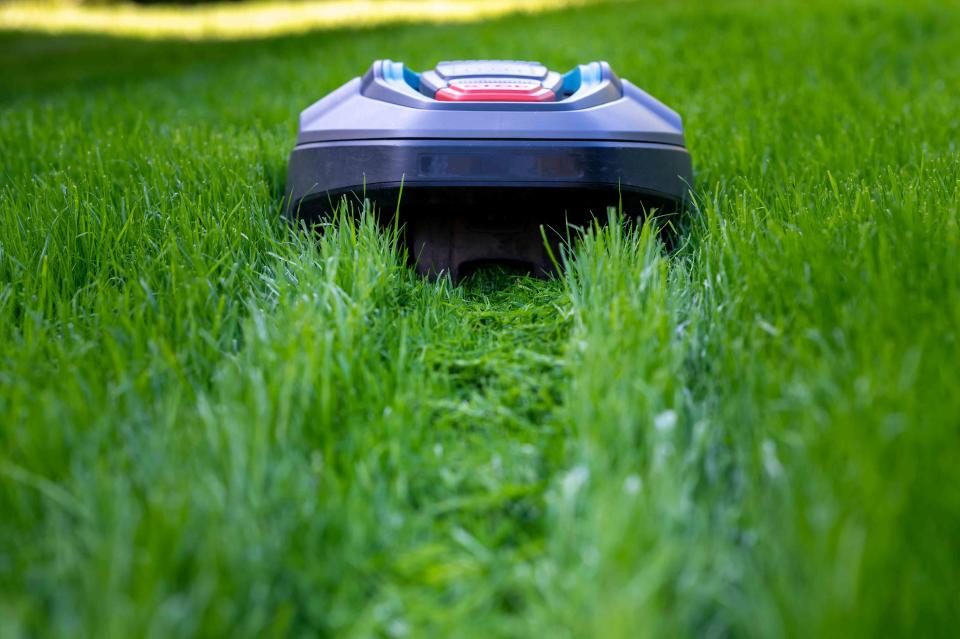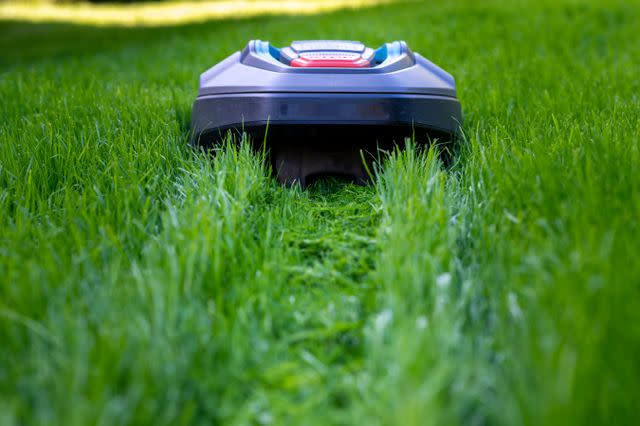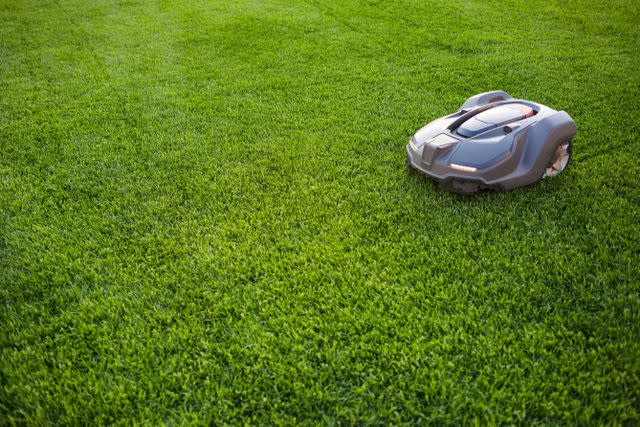Are Robotic Mowers the Future of Lawn Care?
Robotic lawn mower experts sat down with us to discuss this cutting-edge technology.

In the everyday hustle and bustle of life and work, we often turn to technology to save us valuable time on tedious housework. Whether it’s your digital coffee maker, dishwasher, electric stand mixer, or robo-vacuum, advances in technology are helping homeowners everywhere spend less time on household tasks and more time doing the things that they love. It may come as no surprise, then, that you can now automate the lawn mowing process, as well.

Just like robotic vacuums can clean your house with just a few simple settings, robotic lawn mowers can keep your yard looking healthy and well-maintained while you sit back and enjoy some much-needed R&R. If you are curious about robotic mowing but are hesitant to make the switch, here’s everything you need to know about this cutting-edge (pun intended) technology.
Related:The 8 Best Lawn Mowers to Keep Your Yard Neat and Trim
What Is Robotic (Or Autonomous) Mowing?
Put simply, a robotic mower is an autonomous lawn mower that is used to cut and maintain grass in a yard. Like robotic vacuums, robotic lawn mowers have settings that can be customized depending on the size of your yard and the frequency that you want it cut.
“It is different from traditional mowing in that the mower mows several times per week to constantly maintain the desired height of the grass,” says Scott Porteous, robotics product manager at Husqvarna. “This frequent cutting allows an autonomous mower to only remove a few millimeters of grass at a time, resulting in small clippings that recycle into the soil as a natural fertilizer.”
The concept of robotic mowing isn’t new. In fact, Husqvarna was the first to launch the world’s first fully automatic lawn mower back in 1995. Since then, the market has grown and evolved to continually meet the needs of both homeowners and commercial customers. Today, more homeowners than ever before are turning to robotic mowing as they look to free up valuable time and energy in their day-to-day lives.

How Robotic Mowing Works
Most robotic lawn mowers work within a physical boundary wire that is set up by the homeowner. This wire helps to indicate where the mower should (and shouldn’t) mow, and allows the user to create a cutting route within that boundary if desired. Once this initial set up is complete, robotic mowing is a pretty hands-off operation. After each mowing session, the robotic mower will return to its charging base until the next scheduled mow.
However, some robotic mowers, like the new Husqvarna Automower 450X and 450XH EPOS models, operate without the use of boundary wires for an easier and more convenient autonomous mowing solution. These robotic mowers use satellite-based technology to establish the mowing boundaries, which are set and controlled through an app on your phone. Another distinctive benefit of the new industry-leading Automower models is the pattern mowing functionality, which is absent in many standard robotic mowers on the market today. The pattern mowing settings allow homeowners to customize the route that the mower will take to ensure the grass is left with the attractive stripes that many homeowners love, rather than a random cut pattern.
Related:5 Common Mistakes You May Make When You Mow the Lawn
Pros and Cons of Robotic Mowing
So what are the pros and cons of robotic mowing for residential use? Here’s what you should know.
Pro: Less Work for the Homeowner
“The biggest benefit of robotic mowing for homeowners is freedom from the mundane and time-consuming chore of mowing the lawn,” Porteous says. After the initial one-time setup, homeowners can enjoy checking lawn mowing off of their to-do list. That said, as with regular mowing, it’s a good idea to keep a weed trimmer on hand to clean up edges close to rocks or landscaping features that a robotic mower may not be able to reach.
Pro: Self-Charging and Easy Maintenance
Another convenient aspect of robotic mowers is that they are self-charging, meaning they will automatically return to their charging base after each mow. This removes the mental task of remembering to manually charge the battery after lawn mowing, which can be easily forgotten.
“Robotic mowers are [also] easy to maintain—no belts, gas, or oil to worry about, just regular blade changes and cleaning is all it takes to keep your Automower running,” Porteous says.
Pro: Reduced Noise
If noisy neighbors drive you crazy, you’re not alone! According to a recent survey by Husqvarna, “nearly a fifth of Americans have considered moving because of difficulty with a neighbor, while loud lawn equipment proves to be one of the most troublesome distractions.”
Good news: Unlike gas-powered products and some electric mowers, robotic lawn mowers are virtually silent. The Automower 450X and 450XH EPOS models, for example, have an average sound level of 58-69 decibels (equivalent to a normal conversation) while traditional gas mowers produce between 95-100 decibels. This means you won’t have to worry about disturbing your neighbors (or your family) with an early-morning or late-night mow while using a robotic mower.
Pro: Better for Your Lawn
Another less well-known benefit of robotic mowing is the fact that it is actually better for your lawn than other kinds of lawn mowing.
“The robotic mowing style of frequently cutting small amounts of grass is healthier for your lawn than the traditional method of waiting for grass to grow tall and then cutting it short,” Porteous says. Plus, autonomous mowers are mulching mowers, which means the grass clippings are returned to the lawn, acting as a natural fertilizer.
Con: The Price
Undoubtedly, robotic mowers are more expensive than electric push mowers and gas-powered mowers. However, it can be helpful to look at the price as a one-time investment into the health and betterment of your lawn that allows you to save valuable time on household chores. If things like time and energy savings, increased convenience, and a healthier lawn are important to you, than the machine will easily pay for itself.
Con: Initial Setup
The initial set up can take anywhere from two to five hours depending on the model of robotic mower that you are working with. Usually, there are technicians that you can hire to complete the setup for you, or you can try to DIY it if you want. The size of your yard, the complexity of the machine, and whether or not you need to set up boundary wires will all factor into the setup time.
Con: Boundary Wires
Lastly, the use of boundary wires can be troublesome for some homeowners. While they are designed to be durable and withstand the elements, it’s possible to experience breaks in the boundary wire over time, which may cause disruptions in the mowing schedule. Additionally, any change to the layout of a yard will mean that the boundary wire needs to be reinstalled to properly reflect the new boundary.
This is why new wire-free robotic lawnmower models are so convenient and cutting edge for homeowners.
“Husqvarna’s EPOS technology uses exact satellite positioning to create virtual boundaries so you no longer need to worry about boundary wire breaks,” says Chad Fuhrman, director of product management at Husqvarna. “If there are ever any changes to the yard, like the addition of a pool, EPOS technology allows for customers to make changes to their work area directly from their phone rather than re-wiring portions of the yard.”
While the concept of robotic mowing certainly isn’t new, recent advancements in technology have made this autonomous mowing solution more attractive to homeowners than ever before. You may see a robotic mower on your block before you know it—and don’t be surprised if you’re tempted to bring one home yourself soon after.
Related:6 Beginner Lawn Care Mistakes that Keep Lush Grass from Growing
For more Better Homes & Gardens news, make sure to sign up for our newsletter!
Read the original article on Better Homes & Gardens.

